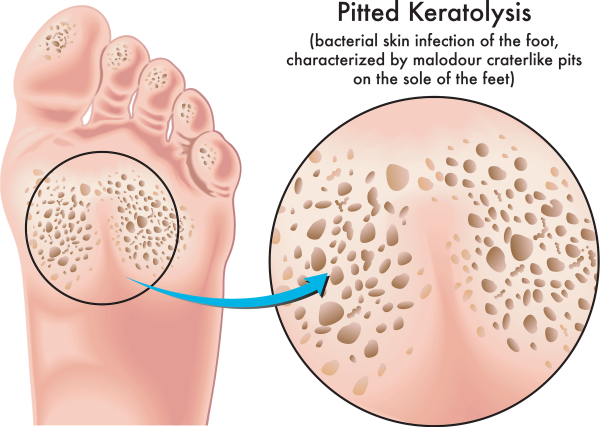Pitted keratolysis (keh·ruh·taa·luh·suhs) is a condition that can cause discomfort, among other symptoms, and should be treated by a professional. Today, we’ll cover the causes, symptoms, and treatment options so your feet can get out of the pits!
What Is Pitted Keratolysis on Your Feet?
Also called keratoma plantare sulcatum, this is a bacterial infection that typically affects the soles of your feet. However, it may also affect the hands, including between the fingers, around the nails, and on the palms. The “pitted” part of the name comes from the pits or small holes left in the skin as the bacteria destroys outer layers of skin cells.

Unfortunately, this condition will not go away on its own and usually requires treatment from a medical professional, such as a podiatrist. Luckily, pitted keratolysis is not contagious.
The Culprits (Causes)
In the vast world of bacteria, there are a few main culprits for this infection:
- Dermatophilus congolensis
- Corynebacterium
- Micrococcus sedentarius
These bacteria love warm, moist environments, including sweaty feet, which means individuals with hyperhidrosis may be more likely to develop an infection.
Symptoms of Feet Pitted Keratolysis
Common symptoms include:
- The noticeable pits on your skin.
- An unpleasant smell as the bacteria releases a sulfur compound (stinky!).
- Brown appearance around the pits, making your foot look dirty.
- Dry, itchy feet.
If your feet are dry and itchy without a pitted appearance you may have foot eczema. The ball of your foot and the heel are common areas of infection and it can affect any age group, but it is more often seen in men than women.
Diagnosis & Similar Conditions
Unlike sores on your feet that could have multiple causes, pitted keratolysis is only caused by bacteria. Although a doctor’s diagnosis is pretty straightforward— they look for the pits and bad smell— they may take a bacterial culture to identify which bacteria is the culprit.
Treatment and How To Prevent Pitted Keratolysis
We have great news! Treatment is easy! Your podiatrist will prescribe you a cream, likely one of these:
- Clindamycin
- Erythromycin
- Fusidic acid
- Mupirocin
If the cream is used as prescribed, the odor and pits should clear up in about three to four weeks. Prevention of infection or reinfection includes wearing proper shoes and breathable socks, as well as open-toed footwear when in warm, moist conditions like indoor pools.
Get Treated for Foot-Pitted Keratolysis Faster!
Pitted keratolysis is no walk in the park. If your feet are showing signs of pitted keratolysis, it’s time to visit the professionals!
Schedule an appointment with The Foot & Ankle Group today.
Categorized in: Blog
Comments are closed